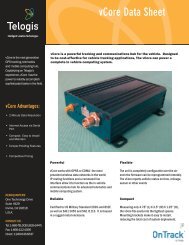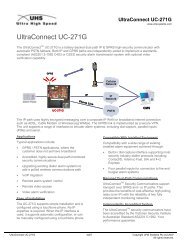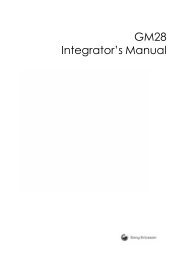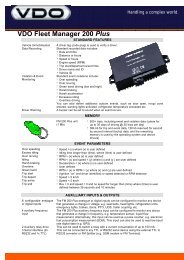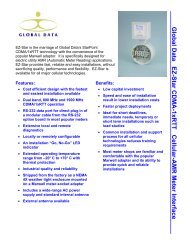Hardware Interface Description - KORE Telematics
Hardware Interface Description - KORE Telematics
Hardware Interface Description - KORE Telematics
Create successful ePaper yourself
Turn your PDF publications into a flip-book with our unique Google optimized e-Paper software.
XT55/56 <strong>Hardware</strong> <strong>Interface</strong> <strong>Description</strong><br />
Confidential / Released<br />
s<br />
Function Signal name IO Signal form and level Comments<br />
SIM interface<br />
GSM_CCIN I R I ≈ 100kΩ<br />
V IL max = 0.5V<br />
V IH min = 2.15V at I = 20µA,<br />
V IH max=3.3V at I = 30µA<br />
GSM_CCRST O R O ≈47Ω<br />
V OL max = 0.25V at I = 1mA<br />
V OH min = 2.3V at I = -1mA<br />
V OH max = 2.73V<br />
GSM_CCIO IO R I ≈10kΩ<br />
V IL max = 0.5V<br />
V IH min = 1.95V, V IH max=3.3V<br />
R O ≈220Ω<br />
V OL max = 0.4V at I = 1mA<br />
V OH min = 2.15V at I = -1mA<br />
V OH min = 2.55V at I = -20µA<br />
V OH max = 2.96V<br />
GSM_CCCLK O R O ≈220Ω<br />
V OL max = 0.4V at I = 1mA<br />
V OH min = 2.15V at I = -1mA<br />
V OH max = 2.73V<br />
GSM_CCVCC O R O max = 5Ω<br />
GSM_CCVCCmin = 2.84V,<br />
GSM_CCVCCmax = 2.96V<br />
Imax = -20mA<br />
GSM_CCGND<br />
Ground<br />
GSM_CCIN = high, SIM<br />
card holder closed (no card<br />
recognition)<br />
Maximum cable length<br />
200mm to SIM card holder.<br />
All signals of SIM interface<br />
are protected against ESD<br />
with a special diode array.<br />
Usage of GSM_CCGND is<br />
mandatory.<br />
ASC0<br />
interface<br />
GSM_RXD0<br />
GSM_TXD0<br />
GSM_CTS0<br />
GSM_RTS0<br />
GSM_DTR0<br />
GSM_DCD0<br />
GSM_DSR0<br />
GSM_RING0<br />
O<br />
I<br />
O<br />
I<br />
I<br />
O<br />
O<br />
O<br />
V OL max = 0.2V at I = 1mA<br />
V OH min = 2.35V at I = -1mA<br />
V OH max = 2.73V<br />
V IL max = 0.5V<br />
V IH min = 1.95V, V IH max=3.3V<br />
GSM_DTR0, GSM_RTS0: Imax = -90µA<br />
at V IN = 0V<br />
GSM_TXD0: Imax = -30µA at V IN = 0V<br />
First serial interface for AT<br />
commands or data stream.<br />
To avoid floating if output<br />
pins are high-impedance,<br />
use pull-up resistors tied to<br />
GSM_VDD or pull-down<br />
resistors tied to GND. See<br />
Chapter 3.3.2.1.<br />
If unused keep pins open.<br />
ASC1<br />
interface<br />
GSM_RXD1<br />
GSM_TXD1<br />
GSM_CTS1<br />
GSM_RTS1<br />
O<br />
I<br />
O<br />
I<br />
V OL max = 0.2V at I = 1mA<br />
V OH min = 2.35V at I = -1mA<br />
V OH max = 2.73V<br />
V IL max = 0.5V<br />
V IH min = 1.95V, V IH max=3.3V<br />
I I max = -90µA at V IN = 0V<br />
Second serial interface for<br />
AT commands.<br />
To avoid floating if output<br />
pins are high-impedance,<br />
use pull-up resistors tied to<br />
GSM_VDD or pull-down<br />
resistors tied to GND. See<br />
Chapter 3.3.2.1.<br />
If unused keep pins open.<br />
Digital audio<br />
interface<br />
GSM_RFSDAI<br />
GSM_RXDDAI<br />
GSM_SCLK<br />
I<br />
I<br />
I<br />
V OL max = 0.2V at I = 1mA<br />
V OH min = 2.35V at I = -1mA<br />
V OH max = 2.73V<br />
If unused keep pins open.<br />
GSM_TFSDAI<br />
GSM_TXDDAI<br />
O<br />
O<br />
V IL max = 0.5V<br />
V IH min = 1.95V, V IH max=3.3V<br />
I I max = 330µA at V IN = 3.3V<br />
XT55/56_hd_v02.06a Page 92 of 125 17.12.2004



